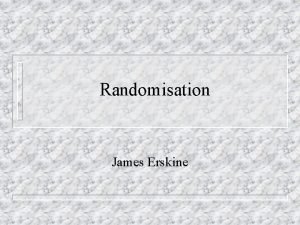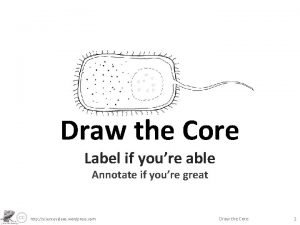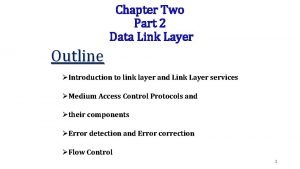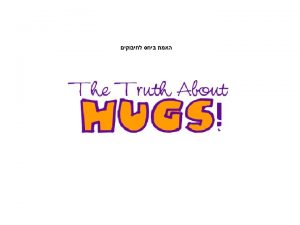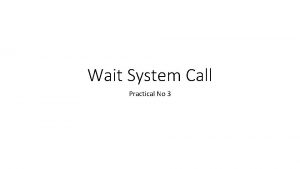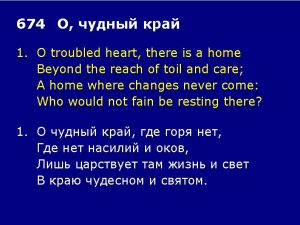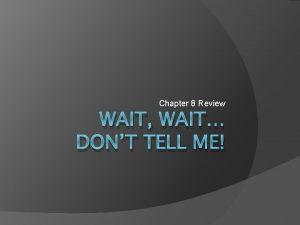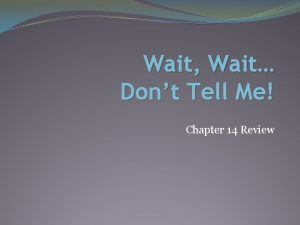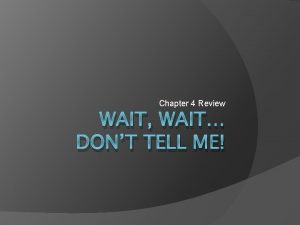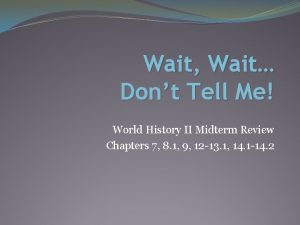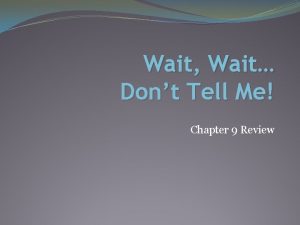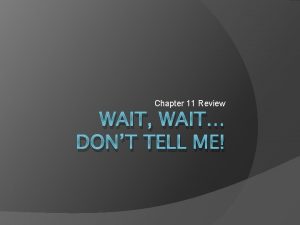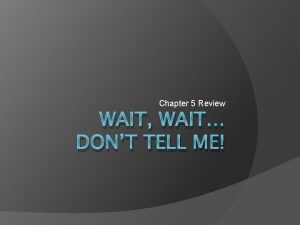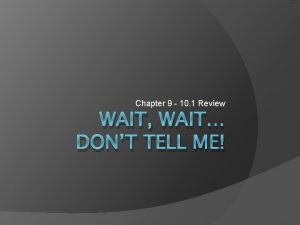If you wait to do everything until youre













































- Slides: 45

“If you wait to do everything until you’re sure it’s right, you’ll probably never do much of anything. ” - Will Borden Children grow faster in springtime.

World War II Here Come the Nazis






The Major Causes of WWII n n n n n Policy of Appeasement Fear and spread of Communism Expansionism: Japan and Germany Fascism/Authoritative governments. Militarism: Japan and Germ. ; Racism: Germ. Nationalism: Germ. Treaty of Versailles Weak League of Nations The world wide Depression

The Major Causes of WWII n n n n World War I Collapse of the Weimar Republic and the rise of Nazism Italian invasion of Ethiopia Spanish Civil War Anschluss Munich Agreement Molotov-Ribbentrop Pact Invasion of Poland, S. U. , and Pearl Harbor.

The Invasion of Poland Ju 87

Ju 52 and Their Motto n "Whether figures, gasoline, bombs or bread, we bring Poland death. "

The Invasion of Poland n On Sept. 1, 1939, the Germ. Luftwaffe flew over the Polish border and began bombing selected targets. n While this was occurring, armored tank divisions known as panzers crossed the border. n Following the panzers: an infantry composed of a million and a half men in motorized vehicles. n All of these combined to create the new Germ. war strategy of blitzkrieg: “lightning war. ”


The Invasion of Poland




The Invasion of Poland n Blitzkrieg: an offensive operational-level military doctrine which involves an initial bombardment followed by the employment of mobile forces attacking with speed and surprise to prevent an enemy from implementing a coherent defense. n However, although the Germ. army used blitzkrieg tactics, they still were being cautious in their attack by using Vernichtungsgedanken, or a focus on envelopment to create pockets in broad-front annihilation.



Vernichtungsgedanken

Poland vs. Germany

Poland vs. Germany

The Invasion of Poland n Sept 1. 1939: Germ. invades after a staged “Polish attack” (Gleiwitz incident; Aug. 31) on Germ. n Sept. 17: Polish forces are being pushed back by Germ. ; S. U. invades Poland (M-R Pact). n Oct. 1: Germ and S. U. have taken control of Poland – gov. never surrendered. The remaining Polish land air forces were evacuated to Romania and Hungary; they would later join with allied Fr. Resistance movements began to form. n n

Soviet Invasion

Why Did Germany and the Soviets Invade? n n n n Germany: Lebensraum: living space in the E. East Prussia was separated by the Polish Corridor: wanted to untie the Reich. They wanted the port city of Danzig. Soviet Union: Wanted to ensure its sphere of influence. They were protecting Ukrainians from Polish “oppression. ”


n Hitler Invades Poland - September 1, 1939 (2: 49)

Aftermath of the Invasion of Poland n Poland was divided between Germ. and the S. U. n 65, 000 Polish troops KIA; 420, 000 captured by the Germ. ; 240, 000 more by the Soviets (660, 000 prisoners). n 120, 000 Polish troops escaped to neutral Romania and Hungary; 20, 000 escaped to Latvia and Lithuania, with the majority eventually making their way to France or Britain. n Most of the Polish Navy succeeded in evacuating to Britain as well. n Germ. : 16, 000 KIA.

Aftermath of the Invasion of Poland n 6 million Polish deaths: over 20% of the country's total population, and over 90% of its Jewish minority. n Mass murder of 3 million Poles, regardless of religious beliefs in extermination camps like Auschwitz, in concentration camps, and in numerous ad hoc massacres where civilians were rounded up, taken to a nearby forest, machine-gunned, and then buried, regardless of whether they were actually dead or not.

Aftermath of the Invasion of Poland


Aftermath of the Invasion of Poland n Sept. 3, 1939: Fr. and Brit. declare war, but do nothing to help Poland. n The Western Betrayal: in spite of having promoted democracy and self-determination, signing pacts and forming military alliances during World War I — nonetheless betrayed their Central European allies by abandoning these pacts.

“England! Your deed!”

The “Phony” War n n Winter 1939 - Spring 1940: all quiet on the western front. Sitzkrieg: sit-down war (Germ. ) Phony war: Brit. and Fr. However, when Finland fell to the Soviets, the British took steps to make sure the same fate would not happen to Norway by mining Norwegian waters in April 1940: blocking trade with Germ.

Hitler Looks to the West n Hitler used the Brit. mining to support his claim that the allies were going to invade Scandinavia. n Hitler sends Norway and Denmark an ultimatum that they accept “protection from the Reich; ” Denmark accepts, Norway does not. n April 9, 1940: Germ. invades Copenhagen (capital of Denmark) with little resistance and takes control.

Denmark

Hitler Looks to the West n April 9, 1940: Germ. launches an invasion of Norway while invading Denmark. n Brit. forces had been busy laying mines in Norwegian waters in an effort to cut off Germ. shipment of iron ore from neighboring Sweden. n Despite Brit. efforts, Germ. was able to capture Norway’s major cities, including the capital of Oslo. n Although Germ. was now in control of Norway, it came at a high cost: Brit. mines destroyed a large number of destroyers and cruisers, however, Hitler won access to the Atlantic.

Norway www. cnn. com/WORLD/europe/9812/10/nobel/index. html


After Demark and Norway n The fall of Norway resulted in the Norway Debate in London. n The Norway Debate took place in the Brit. House of Commons May 7 -8, 1940. The Labour and Liberal opposition strongly attacked Prime Minister Neville Chamberlain and his policies. Knowing that he had lost confidence of his own Conservative party as well, Chamberlain stepped down. n n May 10, 1940: King George VI appoints Winston Churchill (recommended by Chamberlain; one of the few politicians to warn of the Nazi danger in the 1930 s) as the new Prime Minster and asks him to form a new gov.


King George VI and Winston Churchill

Winston Churchill n Adopted a policy of no surrender, even when defeat seemed imminent, and refused to make any negotiations with Germ. throughout the war. n Churchill kept democracy alive in the UK and created the basis for the later Allied counterattacks of 1942 -45, with Britain serving as a platform for the supply of the Soviet Union and the liberation of Western Europe.

n Winston Churchill (06: 37)
 Juan continued playing although he injured his knee
Juan continued playing although he injured his knee Jesus you are my lord
Jesus you are my lord I am writing email
I am writing email How to act angry
How to act angry Hello everyone good morning
Hello everyone good morning Jesus is my firm foundation
Jesus is my firm foundation You're so random
You're so random Your my master
Your my master I dont know where youre going
I dont know where youre going Am i asexual
Am i asexual Acrostic poem happy
Acrostic poem happy How youre
How youre Youre goals
Youre goals Draw the core
Draw the core Im ok youre not ok
Im ok youre not ok Will you fight now or wait for this
Will you fight now or wait for this Hooray cheered gilda. does that mean we can stay
Hooray cheered gilda. does that mean we can stay They do their homework last night
They do their homework last night Until we meet again prayer
Until we meet again prayer A brick sits on a table until you push on it.
A brick sits on a table until you push on it. A brick sits on a table until you push it
A brick sits on a table until you push it Lord i lift everything to you
Lord i lift everything to you Everything around you is made up of
Everything around you is made up of How to put god first in everything you do
How to put god first in everything you do Everything you need to know about the odyssey
Everything you need to know about the odyssey Everything that lives and moves will be food for you
Everything that lives and moves will be food for you Steven johnson everything bad is good for you
Steven johnson everything bad is good for you Everything around you is made up of
Everything around you is made up of Stop-and-wait arq
Stop-and-wait arq Watch, wait and wonder
Watch, wait and wonder Mongolian clans
Mongolian clans Is determined a tone
Is determined a tone Please wait. the webinar will begin soon
Please wait. the webinar will begin soon Ipass the baton example
Ipass the baton example Privisol
Privisol What is fluent wait in selenium
What is fluent wait in selenium Rest in the lord and wait patiently for him
Rest in the lord and wait patiently for him Verb 1
Verb 1 Cmd script wait
Cmd script wait Fork exec
Fork exec Cxpacket sql 2005
Cxpacket sql 2005 Care ikinci hali
Care ikinci hali Everlasting god we set our hope
Everlasting god we set our hope Efpia wait indicator
Efpia wait indicator Stop-and-wait arq
Stop-and-wait arq Stop-and-wait arq
Stop-and-wait arq






